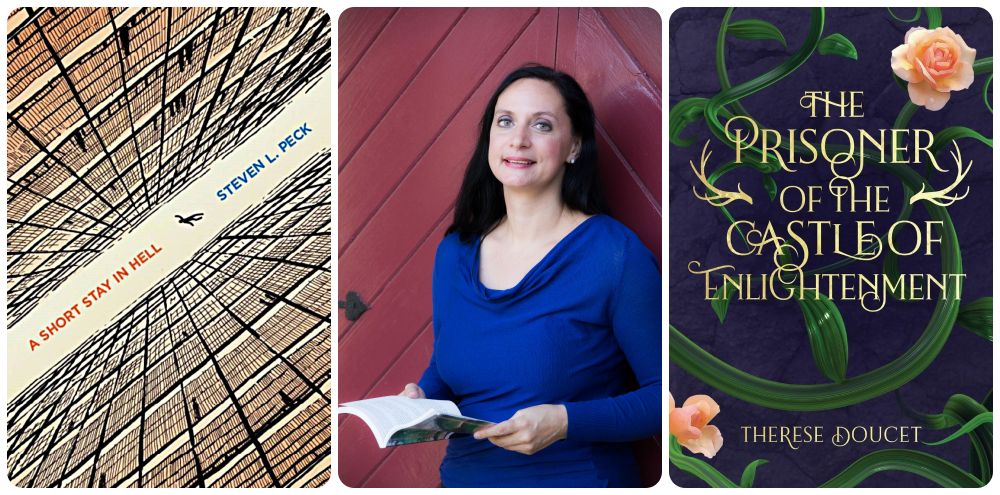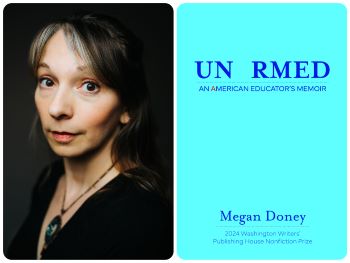Why SFWP’s Andrew Gifford can’t stop putting out good books.

Andrew Gifford, one of the pillars of the independent-publishing community, is “addicted” to the publishing business. He’s based here in the DC area, even though the name of his company is Santa Fe Writers Project (SFWP), and he believes in books even if “the reality is that I’m running a literary press in a barely literate country.”
Gifford scares me sometimes — and educates me continually — as a writer, editor, and publisher with his hard-won, tough-love frankness about the industry. He’s become a mentor to me at the Washington Writers’ Publishing House, so I can personally attest to his sharp-as-nails acumen.
Writers, the SFWP Literary Awards will open for submissions in 2025. However, there is so much more to this publisher and his press. Get ready for a fast education!
You’ve commented in the past that publishing goes in 20-year cycles. Are we in the beginning, middle, or end of a cycle now?
The “20-year-trend” cycle is a popular theory all across pop culture. I’m going to go ahead and say that covid and the aftermath, at least in the literary industry, changed everything. Publishing in the 2020s is nothing like it was in 2019. Social media has been neutered as a marketing tool. We all learned the hard way how delicate the supply chain is and how it’s steadfastly trapped in a non-adaptable, mid-20th-century mindset. Book distribution is falling apart. The cost of manufacture has tripled…On and on. We’ve gone from a fairly reliable cyclical world where the pendulum shifted between the Big Five to the indies into what is essentially a wild, lawless frontier. I think the cycle is broken, and now we have to pave a new path. I believe this decade will see a massive sea change in how we publish, promote, and even consume and enjoy books.
You’ve compared publishing to an addiction. Is it still?
It’s the only reason I’m still doing it. Each book costs me around $15-$20K. I need to shift about 2,000 units to break even. Remove all the literary magic and, at the base level, I’m an investor putting his money into a product. But this isn’t just some widget that you can mass-market and sell to the kids. Fold the literary mindset back in, and the reason I’m making this investment is because I believe in the product. I love it. So, I choose to sacrifice for it. My hope is that there’s a good ROI. The reality is that I’m running a literary press in a barely literate country. Continuing to do this decade after decade is a labor of love, and I don’t think many people would consider it rational. It’s hard, but…I just can’t get enough. Each book is a new fix.
What about publishing your own memoir (We All Scream, about Gifford’s family and their iconic ice-cream business) changed your ideas about marketing/outreach/publishing for indie authors?
Some of my authors might tell you I’m demanding when it comes to encouraging them to get out there and market themselves. They’ll say I don’t understand how hard it is, or that marketing is the publisher’s job. But I’m also an author. It’s eight years since my book came out, and I’m still flogging it when I can. Every author — and the Big Five would agree — needs to get out there and sell themselves. Hell, Stephen King still has to do it. As a publisher, I know what subrights agents and sales reps are looking for: It’s the author’s brand. They champion authors, not publishers. Over the last 30 years, I’ve made a study of this. My authors all have access to hundreds of pages of guides that direct them through every single element of the process, from signing a contract to keeping your book alive five years later.
What is one big piece of advice for authors you publish now that differs from 10 years ago? Or from 1998, when you started?
In 1998, I think the 20-year cycle started to swing back to small presses. But the publisher, small or large, was God. By the 2010s, we had social media and self-publishing options, and book production and marketing were cheaper and easier. At that point, the voice shifted away from the propaganda of the publisher to the human voice of the author. What I call the “democratization” of the publishing business. And I think we’re solidly in that world, and there’s no going back. I talk to big movers and shakers in Hollywood, and they all say they want to champion small-press voices. The advice to authors today is simple: Now’s your time. Get out there and bang the pots and pans together. But you need to understand book (and self-) marketing. Those authors unwilling or unable to do so need to get off at the next stop.
Will you open for submissions from un-agented writers in 2025? It does look like your literary awards will happen next year.
The contest will return in late 2025, with the winners landing 2027 contracts. As for open submissions, we don’t have to do that ever again. Our publishing calendar is full up for 2025 and 2026, and we’re signing for 2027 and 2028 right now. We’re in high demand. I get hundreds of agented submissions every week. It’s impossible to keep up with them. (Apologies to those folks I’ve failed to respond to.) We have legacy authors who have stayed with us for multiple books, and we have lots of folks who are jumping the Big Five ship in favor of working with us. Twenty years ago, we had to desperately search for manuscripts. Today, there are a thousand in my to-read pile right now as I type this. And that’s with submissions solidly closed.
*****
While working on this SFWP-inspired column, I was also reading a wildly inventive post-apocalyptic speculative climate novel about gargoyles (and humans), City of Dancing Gargoyles by my friend Tara Campbell, published by SFWP this fall, and I could see the mind of Gifford at work. This is a story that grabs you from the opening line, “What is the point of a creature created for rain when there is no more rain?” And Campbell is dedicated to getting the word out in a big way. She’s riding the train to success with this fantastic and fabulous novel; no need for her to get off.
Another fall 2024 SFWP title to highlight is K.E. Semmel’s razor-sharp debut novel, The Book of Losman, about a divorced literary translator from Philly in Copenhagen struggling with Tourette syndrome, a dead neighbor on one floor, and an artist/filmmaker love interest on another. It’s a deep dive into psychological and physical challenges as well as the alienation and loneliness that seem to define our postmodern life. The writer knows this world well and draws on his own experience as a Danish literary translator living with Tourette syndrome. Its publication is an example of someone (Gifford and his team) having a finger on the pulse of the literary zeitgeist.
Looking ahead to spring, one novel from SFWP to put on your TBR pile is The Death and Life of August Sweeney by George Washington University professor of creative writing Samuel Ashworth. To grab the reader, it starts on Sweeney’s autopsy report, though this very colorful, Anthony Bourdain-on-steroids chef is not dead, not yet. “How many pig heads does a man get to cook in his lifetime?” August asks his assistant, Chucho, as they dispose of one in the opening chapter. At the end of the scene, “Chucho looked at him funny, but said, Okay chef, but if you die, I get your knives, right?”
The promise of this death — and life — is thick with morbid humor and complex, funny characters. It’s an addictive read, a trademark of the books from a publisher “addicted” to this precarious and wild publishing life.
[Photo by John Casper Photography.]
Caroline Bock writes stories — from micros to novels. She is the author of the novel The Other Beautiful People, forthcoming from Regal House Publishing in summer 2026. A graduate of Syracuse University, she studied creative writing with Raymond Carver and poetry with Jack Gilbert and Tess Gallagher. In 2011, after a 20-year career as a cable television executive, she earned an MFA in fiction from the City College of New York. She has short fiction forthcoming in the Hopkins Review. She is the co-president and prose editor at the Washington Writers’ Publishing House. She lives in Maryland with her family.

